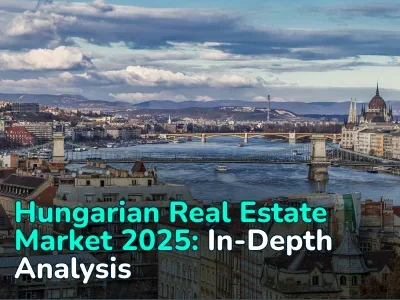
The US Mortgage Market in 2025: High Rates, Housing Shortages, and Trump's Idea of a 50-Year Mortgage
By the end of 2025, the American housing market had reached a state many economists describe as the most challenging in the past four decades. Households are entering a period in which the cost of owning a home, driven mainly by high mortgage rates, is rising faster than incomes.
Although the average rate on a 30-year mortgage has fallen to about 6.2%, it remains high considering that in 2020 and 2021 it was close to 3%. Home prices grew at double-digit rates during that period and have only recently stabilized at about 1.5–2% per year.
This has caused a sharp drop in housing affordability. Against this backdrop, the idea of a 50-year mortgage, promoted by Donald Trump, has attracted attention. Supporters argue that extending the loan term can lower monthly payments and give some buyers a chance to purchase a home. Critics believe that this only reinforces high prices instead of addressing the core issue.
We decided to examine the current state of the U.S. housing market, evaluate what is happening with mortgage lending, and understand how longer mortgage terms could influence the market.
What Is Happening in the U.S. Mortgage Market
At the moment, the U.S. housing market combines conditions that almost never occur at the same time. Rates and prices are close to historic highs, while transaction volumes are near historic lows.
After two years of large fluctuations, the average rate on a 30-year fixed mortgage has stabilized slightly above 6%. Formally this is an improvement, since in 2023 and 2024 rates exceeded 7%. In real terms the change is less significant, because in 2020 and 2021 the market had adjusted to rates near 3%. At that level a household could afford a home priced 30 to 40% higher than it can now.
Because of this, the market has not returned to its pre-pandemic trajectory. The main reason is the so-called rate lock-in effect. Millions of Americans took out mortgages during the ultra-low-rate period of 2020 and 2021. If they want to sell now, they face difficulty, since switching to a new mortgage at 6% would sharply increase their payments even for a similarly priced home.
Homeowners therefore remain in place. This has produced an unusual situation for the U.S. market, with the number of homes listed for sale falling to historic lows. Even buyers who are ready to purchase have very little to choose from.
New Housing in the U.S.
The above refers mainly to existing homes. The new-construction market also shows mixed conditions. New building activity should have compensated for the shortage of supply, but when rates rose to 6–7% in 2022 and 2023, developers significantly reduced the number of new projects.
As a result, by 2025 the accumulated housing shortfall in the United States reached about 4.7–4.9 million units, while annual construction added only about 1.3 million homes. The market, therefore, needs an additional 3–4 million units on top of the normal pace.
The imbalance is worsened by the fact that most new construction targets the higher end of the market. According to Pew Research, in 2023 only 87,000 new single-family homes of about 130 m² were completed. This is 8.7% of total completions, although this size category is one of the most popular. About 26% of buyers look for homes of this type. Developers instead focus on homes averaging 211 m² with a higher price of about 428,600 dollars.
This has disrupted supply and demand across all segments. Existing inventory is limited, new construction is growing in a segment where shortages are less critical, and buyers in the middle and lower price ranges have to compete for a small pool of homes.
Earlier, most transactions involved households buying their first or second home with a standard 30-year mortgage. Their share was 38 to 40% of all deals. Now their share has fallen to about 21%.
At the same time, cash purchases have reached a record level of 28.8%. Only affluent private buyers and institutional landlords can afford this, and the market has shifted toward them. Sellers prefer such buyers, so a typical mortgage borrower often loses in competition for a property.
Existing Mortgage Programs in the United States
For decades, the U.S. housing market has been built around long-term fixed-rate loans. These loans provide predictable payments over the full term and allow households to plan their financial life over a horizon of 20 to 30 years.
30-Year Fixed-Rate Mortgage
The 30-year fixed-rate mortgage is the primary and historically dominant product in the U.S. mortgage market. This happened for clear reasons, because the product has three key features.
- Predictable payments. The interest rate is locked at the moment the loan is issued and does not change for 30 years. This protects the borrower from interest rate shocks. Even if market rates rise, the monthly payment remains the same.
- A balanced price-to-payment ratio. The average monthly payment for such a mortgage is about 2,400 dollars per month. This is high but still manageable for many households. The closest alternative, a 15-year mortgage, costs around 3,600 dollars per month, which is almost 1,000 dollars more.
- Rapid equity growth in the first 10 to 15 years. With a 30-year term, borrowers accumulate meaningful home equity by the midpoint of the loan through principal repayment and home price appreciation. This allows them to refinance, take out home equity loans, or sell the property with capital gains.
In practice, the 30-year mortgage has become the financial backbone of the American household. Families plan spending around it, build long-term wealth, make decisions about moving, and shape their retirement strategy.
15-Year Mortgage
The 15-year mortgage holds a noticeably smaller share of the U.S. market. It is chosen by buyers who want to build equity faster, reduce total interest costs, and eliminate debt within a single generation rather than two.
The difference in monthly payments between the 15-year and 30-year options is substantial. However, because the principal is paid down far more rapidly, the household spends much less on interest, which becomes especially important in a high-rate environment.
In a 30-year mortgage, the first 7 to 10 years of payments mostly cover interest. In a 15-year mortgage, the share of principal repayment begins to grow meaningfully from the first months. This gives the owner the ability to sell the home with a profit, obtain a home equity loan, or refinance much sooner.
Adjustable-Rate Mortgage (ARM)
The adjustable-rate mortgage, or ARM, has traditionally held a smaller share of the market compared with the standard 30-year fixed loan. In 2024 and 2025, its share ranged from 6 to 10% of all new mortgages.
Its structure is based on two key stages.
Stage 1. Fixed-rate period for 5, 7, or 10 years. Standard products include the 5/1 ARM, 7/1 ARM, and 10/1 ARM. The first number shows how many years the rate remains fixed. The second number indicates how often the rate can be adjusted after that period, usually once per year. In 2025 the average starting rates looked as follows:
- 30-year fixed mortgage: about 6.2 to 6.5%.
- 5/1 ARM: about 5.1 to 5.6%.
- 7/1 ARM: about 5.3 to 5.8%.
- 10/1 ARM: about 5.5 to 6.0%.
The difference in rates lowers the monthly payment by roughly 7 to 12%, which is significant for expensive properties. For this reason ARM activity usually rises in periods when fixed-rate loans become costly.
Stage 2. Transition to a floating rate. After the initial period ends, the rate becomes tied to a market benchmark. In the United States the main reference index is SOFR, the Secured Overnight Financing Rate.
The adjusted rate is calculated using SOFR plus the lender’s margin, which is usually 2.25 to 3.00 percentage points.
Example:
- SOFR = 5.3%.
- Margin = 2.5%.
- Final rate after the fixed period = 7.8%.
To protect borrowers from sharp increases, ARM contracts include so-called caps, which limit rate changes.
- Initial adjustment cap: the rate cannot rise by more than 2 percentage points at the first adjustment.
- Annual cap: in subsequent years the increase cannot exceed 1 percentage point per year.
- Lifetime cap: the rate cannot rise by more than 5 percentage points above the starting rate at any point.
Despite the appealing introductory rate, ARMs have not seen major growth. One reason is that the steep rise in ARM rates in 2008 became one of the triggers of widespread defaults and the global financial crisis.
At the same time, ARMs are now slightly more advantageous than 30-year fixed mortgages. If rates continue to rise, the share of ARMs in new transactions may increase.
Government Mortgage Programs
Government-backed mortgage programs in the United States occupy an important segment of the market. However, they are not a universal solution to the affordability problem and, in some respects, can even introduce additional risks.
- FHA (Federal Housing Administration). The main advantage of the FHA program is the low minimum down payment of 3.5% and more flexible credit requirements. At the same time borrowers must pay mortgage insurance, known as MIP, and payments continue for the entire life of the loan. In conventional mortgages this insurance can be removed once a certain share of the principal has been repaid.
- VA (Veterans Affairs). The VA program is intended for veterans and active-duty military personnel. It allows buyers to take a loan with a zero down payment, without private mortgage insurance, and with several additional benefits.
- USDA (Rural Development). The USDA program targets rural areas and small towns. Loans are also available with zero down payment, and eligible regions receive specific benefits. However, the program rarely applies to larger or mid-sized cities.
What Trump Proposes
In a situation where simply lowering interest rates is not enough to revive the market, the U.S. president has introduced the idea of a 50-year mortgage. The logic is straightforward: extending the loan term to 50 years reduces the monthly payment compared with a 30-year loan and may bring young buyers and middle-income families back into the market.
Supporters base their arguments on three main points:
- Rates remain high, and prices are near historic peaks, so the focus shifts to lowering the monthly burden rather than changing prices or reforming construction policy.
- Extending the term lowers the payment by about 10 to 15% even at the same interest rate. This makes financing accessible for buyers who currently do not qualify under standard criteria.
- Several economies, for example Japan and some European countries, already use 40- to 50-year mortgages, and the United States is adopting elements of that model.
At the time of the discussion, there were no precise parameters besides the 50-year term. The only clear point is that for such loans to become widespread, the role of government agencies must expand and a dedicated mortgage segment must be created. Longer loans carry a different risk profile and require either new standardized securities or stricter conditions for investors. In practice this means that the proposal would need several years of institutional adjustments before full implementation.
What critics say:
- Much higher total interest costs. Monthly payments would indeed be lower, but the total interest cost becomes significantly larger. At a 6% rate the borrower pays about 180% of the principal over 30 years and about 300% over 50 years.
- Market reaction. If a new group of buyers enters the market while supply remains constrained, prices almost inevitably rise.
- The proposal does not address the supply shortage. The core issue is the lack of affordable homes rather than the lack of long-term loan options. Critics therefore view the idea as treating the symptoms instead of addressing the underlying cause.
How a 50-Year Mortgage Could Affect the Market
If we look only at the size of the monthly payment, the introduction of 50-year loans would indeed make home purchases formally more accessible for some households.
Short-term effects:
- Families that currently fail to meet the debt-to-income limits for a mortgage would enter the market.
- Demand would rise, mainly from young buyers and middle-income households that lack about 200 to 300 dollars per month to qualify for a standard 30-year mortgage.
- Market statistics could improve temporarily: the number of transactions may increase, the share of first-time buyers may rise slightly, and mortgage denial rates could decline.
However, given the current conditions, including limited supply, few existing homes being listed, and slow construction in the affordable segment, there is a strong possibility that additional demand in the mid-to-lower price range will push prices upward and worsen the problem.
At the same time, analysts are basing their conclusions solely on Trump’s initial statement. It is reasonable to assume that the final mortgage package will not simply extend the term to 50 years but will also include additional provisions, possibly aimed at reducing total interest costs and adjusting the rate and monthly payments.
What Is Actually Wrong With Housing Affordability in the United States
A useful perspective comes from Sean Dobson, the CEO and chairman of Amherst Group, one of the key players in the U.S. single-family rental and investment market.
Amherst is a typical example of an institutional landlord. The company buys, builds, and manages single-family homes as long-term investment assets. It manages about 15 to 18 billion dollars in capital and owns tens of thousands of homes, roughly 50 to 57 thousand units according to various estimates, across dozens of metropolitan areas.
“We have probably made housing unaffordable for an entire generation of Americans.”
In an interview with Fortune and in later comments, Dobson outlines several tough points.
- Pandemic-era policy and ultra-low rates pushed prices into a historic imbalance. In his view, emergency stimulus, cheap money, and aggressive rate cuts drove home prices far above what a typical U.S. household can afford.
- The burden of a typical mortgage is now worse than at the peak of the 2006 bubble. Amherst estimates that a standard mortgage currently consumes up to 43 percent of household income. This is noticeably higher than the level that was considered dangerous before the 2008 crisis.
- The correction will take 10 to 15 years. Dobson believes that at current income and price trends, it will take roughly 10 to 15 years of steady wage growth to bring affordability back to minimally acceptable levels.
In his view, this is not another cycle but a long-term structural shift caused by the attempt to cover the economic fallout of the pandemic with cheap money. These points suggest that Trump’s initiative is another simple response to a complex structural problem.
However, his position should be viewed in the context of Amherst’s role. The company is one of the largest institutional landlords in the single-family segment. In practice, firms like Amherst are also part of the reason supply is limited.
It is therefore unsurprising that when discussing the crisis, Dobson promotes another solution: renting instead of buying. In an interview with Fast Company, he emphasizes, “Demand for single-family rentals is rising because people want to live in houses but cannot afford to buy them, and the market is pushing that demand into the rental segment.”
For Amherst and similar companies, this situation is a core source of profit. Worsening affordability increases the number of families who shift from buying to long-term renting. They have no incentive to support lower mortgage rates or a return of first-time buyers to the market. The idea of rising household incomes, however, aligns with their interests, since higher incomes allow people to rent more expensive properties.
In Conclusion
From a simple arithmetic standpoint, a 50-year mortgage addresses the clear goal of lowering monthly mortgage payments. Critics note that the downside is a sharp increase in total interest paid, yet these conclusions are still speculative because the proposal has not been formalized. It would be unrealistic to assume that the product will be identical to the existing mortgage structure but stretched to 50 years. The final version will almost certainly include additional adjustments, possibly related to pricing, interest calculations, and payment structure.
In any case, the main problem in the U.S. housing market is not the absence of longer-term mortgages. The core issue is that prices have moved far ahead of incomes while the market faces a structural shortage of supply. Therefore, if Trump’s idea ends up being limited to extending the term to 50 years will not change the situation. The outcome will still depend on expanding supply, normalizing prices, and achieving steady income growth among households.
Author
I write informative articles about real estate, investments, job opportunities, taxes, etc.























